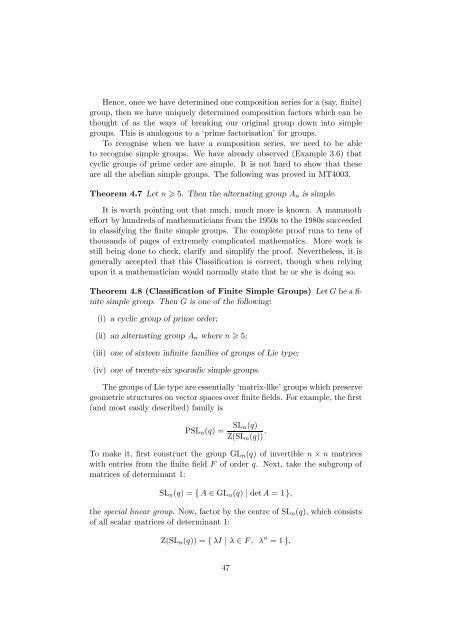The JordanâHölder Theorem
The JordanâHölder Theorem
The JordanâHölder Theorem
Create successful ePaper yourself
Turn your PDF publications into a flip-book with our unique Google optimized e-Paper software.
Hence, once we have determined one composition series for a (say, finite)<br />
group, then we have uniquely determined composition factors whichcanbe<br />
thought of as the ways of breaking our original group down into simple<br />
groups. This is analogous to a ‘prime factorisation’ for groups.<br />
To recognise when we have a composition series, we need to be able<br />
to recognise simple groups. We have already observed (Example 3.6) that<br />
cyclic groups of prime order are simple. It is not hard to show that these<br />
are all the abelian simple groups. <strong>The</strong> following was proved in MT4003.<br />
<strong>The</strong>orem 4.7 Let n 5. <strong>The</strong>nthealternatinggroupA n is simple.<br />
It is worth pointing out that much, much more is known. A mammoth<br />
effort by hundreds of mathematicians from the 1950s to the 1980s succeeded<br />
in classifying the finite simple groups. <strong>The</strong> complete proof runs to tens of<br />
thousands of pages of extremely complicated mathematics. More work is<br />
still being done to check, clarify and simplify the proof. Nevertheless, it is<br />
generally accepted that this Classification is correct, though when relying<br />
upon it a mathematician would normally state that he or she is doing so.<br />
<strong>The</strong>orem 4.8 (Classification of Finite Simple Groups) Let G be a finite<br />
simple group. <strong>The</strong>n G is one of the following:<br />
(i) acyclicgroupofprimeorder;<br />
(ii) an alternating group A n where n 5;<br />
(iii) one of sixteen infinite families of groups of Lie type;<br />
(iv) one of twenty-six sporadic simple groups.<br />
<strong>The</strong> groups of Lie type are essentially ‘matrix-like’ groups which preserve<br />
geometric structures on vector spaces over finite fields. For example, the first<br />
(and most easily described) family is<br />
PSL n (q) =<br />
SL n(q)<br />
Z(SL n (q)) .<br />
To make it, first construct the group GL n (q) ofinvertiblen × n matrices<br />
with entries from the finite field F of order q. Next, take the subgroup of<br />
matrices of determinant 1:<br />
SL n (q) ={ A ∈ GL n (q) | det A =1},<br />
the special linear group. Now,factorbythecentreofSL n (q), which consists<br />
of all scalar matrices of determinant 1:<br />
Z(SL n (q)) = { λI | λ ∈ F , λ n =1}.<br />
47













